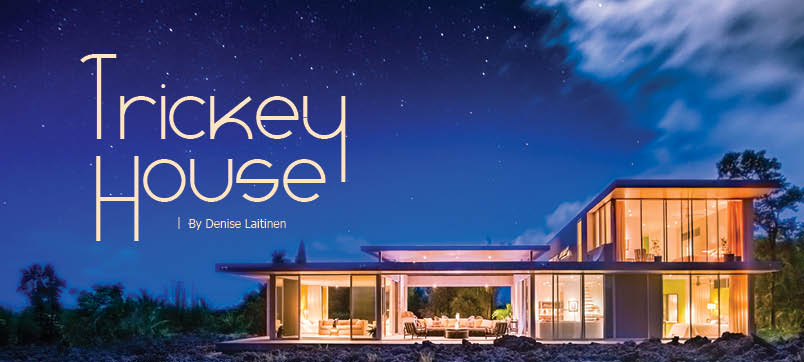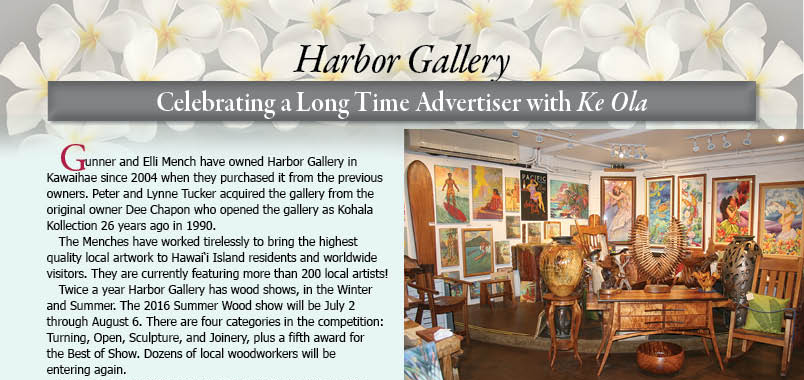
Trickey House
By Denise Laitinen
Over the years, finding Robert Trickey’s house had become something of a Don Quixote adventure for me. When my quest began, I didn’t know that the house belonged to Robert Trickey or that a famous architect designed it.
Years ago, I had come across a newspaper article of a futuristic-looking contemporary home near Kalapana that sat amidst the lava. I remember being enchanted with the juxtaposition of the rough lava and the sharp lines of the home. Being a long-time resident of Puna, I knew it was rare to see contemporary homes in this area. I couldn’t recall where I had read about the house, yet I always remembered it in the back of my mind and even went so far as to drive around neighborhoods looking for it while out on assignment on other stories.
As fate would have it, a friend of mine recently visited the home and told me about it. It was the same home I had been wondering about for years!
When Robert Trickey bought land in a Puna subdivision just down the road from Kalapana, he had no idea the house designer he hired would go on to become a renowned architect. Or that he would start a trend of contemporary homes built in the neighborhood.
No, back in 1999, Robert just knew that it was too rainy in Orchidland for his taste and was looking for another area in Puna that had a little more sun.

He had friends in a small neighborhood near Kehena and bought a property nearby that overlooked the 1955 lava flow. A fan of modern architecture, he also knew he wanted to build a contemporary style house.
Robert, who owned an upholstery and interior design business, had dabbled in small building projects, but had never built a house before.
“I have a friend, David Beardsley, who is a house carpenter. He can build anything and he worked with owner-builders. I really wanted to work with him because I really wanted to build the house with my own hands,” says Robert.
“I thought I had six months or so to get a design together. But David’s schedule opened up and he could build my house right away.”
Only Robert didn’t have any plans ready for the house. He tried designing it himself and failed miserably. One of his employees mentioned that a former customer was a designer and that he should call him.
“Craig Steely had been a client of my upholstery business in San Francisco,” adds Robert.
Craig was just starting out in his design business and also had an appreciation for modern design. The two teamed up to work on Robert’s new home. Craig lived in San Francisco at the time and designed the house based on Robert’s photos and descriptions of the lava. Craig designed an L-shaped home with a lot of interlocking shapes. The pool is also L-shaped, a pattern that is repeated throughout the home.
Robert didn’t realize it at the time that Craig had never built a home before.
“This was actually his first built home. I thought he had more experience.”
Unlike traditional homes, contemporary homes can be challenging to build. All the L-shapes of the house and the pool proved challenging when it came time to turn the design into an actual home.
“Modern houses are very unforgiving in some ways,” says Robert. “They’re more difficult to build, especially in places like Puna where people have not seen this type of home very often.
“Contemporary houses can be more demanding to build because there’s nothing to hide behind,” adds Robert. “It’s really where things connect to each other like roof planes. Something I learned the hard way. When you’re building and you have two edges (say where the wall meets the ceiling), there’s rough framing and then plywood and then sheeting so that the dimension of where you end up is very different from where you started building. You need to do the subtraction on both faces so they meet at the same point.”
“Those kinds of situations were fraught with difficulty,” says Robert, adding that since the house is L-shaped, there were lots of places where two planes intersected. “Everything had to be lined up just right,” says Robert. “You can’t just slap a molding on something or cover up something that didn’t quite meet an alignment.”
“Builders aren’t used to building this kind of home. They might make mistakes, and you either have to live with it or rip it out and start all over.”
For Robert, the square lines and boxy style of the home are all meant to showcase the lava.
“Modern architecture is simple and rectilinear,” explains Robert, “while anything in nature is curvaceous. The box of the home frames the unruliness of nature. Here the lava is very rough and jagged and forbidding while the house is very cool and rational. I wanted it to look like the house was a spaceship that landed on the lava, that landed on this otherworldly landscape,” says Robert.
The property naturally slopes gently from the lava field down to street level. He purposely sited the house on a flat area at the back of his lot so it looks over the lava field.
“It’s about the lava,” says Robert. “I wanted to be able to see through the house to the lava when I walked up to the house. It’s all about the site and how it interacts with the lava.”
“I was like a crazy man telling the construction guys not to dump any construction materials on the lava. I wanted to save as much of the lava as I could.” Because the property is along the border of the subdivision adjacent to state-owned land, the lava fields will never be developed. Over the years, Robert was able to purchase the undeveloped lot next door to his, giving him a total of an acre of land, so now the lava appears to wrap around the house on the side, as well.
“The lava’s got 60 years of skin now,” says Robert. “It’s gone from a pristine state to slowly growing back. It has ferns and lichen on it. The lichen is referred to as ‘Pele’s Snow’. On a full moon the lichen looks like snow, and it’s very beautiful. It’s 60 years of growth of little ‘ōhi‘a trees and small ferns.”
Most of the rooms in the house have floor to ceiling windows and glass doors, so it feels almost as if you are outside, even when sitting at the dining room table. While some of the home’s building materials, like the floor-to-ceiling doors, had to be ordered from the mainland, Robert says more than 80 percent of the materials used in the home were sourced locally.
For instance, the wood for the mango stairs that seem to float in the living room was given to him by a local woodworker who was closing his shop.
“There’s also quite a bit of steel in the house,” adds Robert, “that came from Hilo Steel. A lot of materials came from local purveyors.”
Robert stayed with friends in the neighborhood when construction got underway and said that once there was a frame around one of the interior rooms, he started camping out at the construction site.
“Once there was plywood around the area of what is now the kitchen, I stretched a tarp to cover it and I would stay in there—even when it was raining. I was very hands on, I put in all the windows myself. We had the normal challenges of things taking longer and costing more than we thought, but it was a lot of fun.”
Robert finished building his house in 2000. Since the back of the house overlooks the lava, he added some landscaping in the front yard, only adding dirt where the bulldozer had disturbed ground during the creation of the footpad for the house. Robert also built a small guesthouse in the front that he also used for building and designing furniture.
During the construction phase, Craig, the designer, came to visit from the Bay Area to see how the construction was progressing and fell in love with Puna. Craig called his wife from the construction site to tell her he wanted to live here, too.
After Robert’s house was complete, Craig went on to build his own contemporary house a few streets over from Robert. (Craig’s family spends part of the year in Hawai‘i and part on
the mainland.)
“People driving by would see my house and his house and get interested in the modern design,” says Robert. “People really get the angularity of the house and rugged beauty of the lava.”
Looking back, Robert is thrilled that his is the first house designed by Craig, who went on to become an acclaimed architect winning numerous awards from the American Institute of Architects. It’s akin to having your picture painted by Van Gogh before Van Gogh became famous. There are now four Craig Steely homes in Robert’s neighborhood and at least eight to 10 Steely homes on-island that Robert is aware of plus at least one on Maui.
Robert says that although the house-building process was a definite learning experience, he wouldn’t have it any other way and loves living next to the lava. ❖
Photos courtesy Andrew Hara
Contact Robert Trickey



